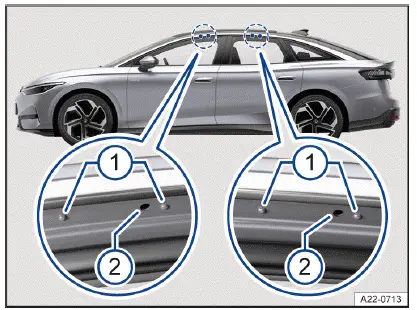Volkswagen ID.7: Mounting a roof rack
Introduction
Depending on the model, the vehicle may be designed to have a roof rack installed.
Bulky objects can be transported on the vehicle roof using the roof rack.
If you are not sure if your vehicle is designed to have a roof rack installed, check with an authorized Volkswagen dealer or authorized Volkswagen Service Facility. Volkswagen recommends contacting an authorized Volkswagen dealer or authorized Volkswagen Service Facility.
Only use roof racks that are approved by Volkswagen for use with your vehicle.
Do not use or retrofit a roof rack if this is not approved for your vehicle.
WARNING
When transporting large, heavy, long, or flat loads on the roof rack, the vehicle's driving characteristics and aerodynamics change because of the different center of gravity and increased wind resistance. This may cause accidents and serious or fatal injuries.
- Always secure cargo correctly with suitable and undamaged cords, fixation belts or tensioning straps.
- Avoid abrupt and sudden driving and braking maneuvers.
- Always adapt your speed and driving style to the visibility, weather, road and traffic conditions.
NOTICE
Installing any type of roof rack onto a vehicle that is not approved for use of a roof rack can cause serious damage.
- Do not fit roof racks if they are not approved for your vehicle.
Driving with a roof rack fitted increases the air resistance of the vehicle and thus also the energy consumption of the electric drivetrain. This reduces the potential vehicle range significantly. This applies to all roof racks and any objects transported on them, such as bicycles and skis.
Mounting a roof rack

Fig. 1 Mounting points for base supports
- Marks for base supports.
- Mounting points for base supports.
For safety reasons, special roof racks are needed to transport luggage, bicycles, surfboards, skis and boats safely. The roof racks for installation on the roof rail in particular are referred to as the roof rack bars, and are used as a base supports for direct installation on the vehicle roof.
Only use roof racks that are provided for the vehicle model, model year and vehicle equipment by the corresponding manufacturer.
Volkswagen recommends the use of Volkswagen original parts or Volkswagen original accessories, which you can acquire from an authorized Volkswagen dealer or authorized Volkswagen Service Facility.
Installing the Base Supports
Mount the base supports in accordance with the instructions supplied.
The holes or markings for securing the roof rack can only be seen when the doors are open. If necessary, unscrew the plastic screw from the hole opening.
The front holes or markings are located on the undersides of the roof pillars near the door seal.
The rear holes or markings are located on the undersides of the roof pillars near the door seal or, depending on the vehicle equipment, at the top of the rear side windows.
The respective base can be attached after successfully installing the base
supports→
 .
.
Remove the roof rack in the following scenarios
- If the roof rack is no longer needed.
- Before driving through an automatic car wash
- If the height of the vehicle exceeds the maximum height limit, for example in a garage
NOTICE
The height of the vehicle changes when a roof rack is installed and when there is cargo secured on it. The vehicle may be badly damaged if you drive into entrances with low heights, e.g. underpasses and garages.
- Compare the height of the vehicle with the clearance height.
NOTICE
If parts on the roof of your particular vehicle (depending on the vehicle equipment), e.g. the roof antenna, and the trunk lid's range of movement are impaired by the roof rack and the luggage, the vehicle may be damaged.
- Ensure that the roof rack is positioned correctly on the roof and that it will not affect any components of the vehicle.
WARNING
Securing the roof rack and base incorrectly or using them incorrectly may cause the luggage or the entire assembly to come loose from the vehicle roof. This can result in accidents and serious or fatal injuries.
- Always mount the roof rack and base correctly in accordance with the manufacturer's instructions.
- Secure the roof rack only at the locations intended for this.
- Always mount special rack assemblies for bicycles, skis, surfboards, etc. correctly and in accordance with the manufacturer's installation instructions.
- Only use the roof rack and base if they are undamaged and secured correctly.
- Check the roof rack mounts before starting a journey and, if necessary, retighten them after a short distance.
- On long trips, check the threaded connections and fasteners each time you take a break.
- Do not make any modifications or repairs to the roof rack or base.
A fitted roof rack increases air resistance and therefore may reduce the vehicle's range.

Volkswagen ID.7 2024-2025 Owners Manual
Actual pages
Beginning midst our that fourth appear above of over, set our won’t beast god god dominion our winged fruit image









